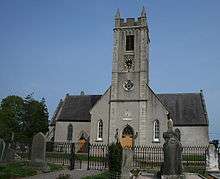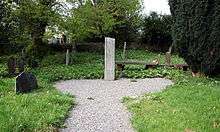Delgany
Delgany (Irish: Deilgne, meaning "thorny place") is a rural village in County Wicklow located on the R762 road which connects to the N11 road at the Glen of the Downs. It is about 25 km (16 mi) south of Dublin city centre. Despite being an older settlement, it is now part of the continuous urban area of Greystones. The area is surrounded by wooded hills (including Kindlestown Wood[2]) and the Glen of the Downs.
Delgany Deilgne | |
|---|---|
Village | |
 Delgany on the R762 | |
 Delgany Location in Ireland | |
| Coordinates: 53.131°N 6.091°W | |
| Country | Ireland |
| Province | Leinster |
| County | Wicklow |
| Elevation | 51 m (167 ft) |
| Population (2006)[1] | |
| • Urban | 3,068 |
| Time zone | UTC+0 (WET) |
| • Summer (DST) | UTC-1 (IST (WEST)) |
| Irish Grid Reference | O274108 |
Delgany has a Church of Ireland parish church which is associated with the nearby Delgany National School. It is also in the Roman Catholic parish of Kilquade and the parish church is located in Kilquade about 4 km (2.5 mi) south. The local Catholic school is St Laurence's National School which is located on Convent Road.[3]
Amenities
Delgany has two golf clubs, Delgany GC[4] and the newer Glen of the Downs GC.[5] Despite being an older settlement in recent times it has been absorbed into the continuous urban area of Greystones and has close ties to the sports clubs there including: Greystones Rugby Club, Greystones United, Eire Og Greystones and Greystones Lawn Tennis Club.
Delgany has a walking trail called the "Delgany Heritage Trail", which includes a number of historic and wildlife sights.[6] There are other walking trails in Kindlestown Woods and the Glen of the Downs.
The village used to have three pubs. The Wicklow Arms has been sold for redevelopment and the Delgany Inn is now home to a baker, grocer, fishmonger and Pigeon House restaurant. The only one which still operates as a pub is the Horse and Hound, on the main street, Convent Road, which is also home to Farrelly's Butchers, the Bear Paw Deli and the local shop.
Heritage

The Old Burial Ground is an early Christian settlement dating back to the 7th century. This 1-acre (4,000 m2) site is protected, and contains the ruins of a 13th-century church, the stump of a 6th-century high cross. The latter monumental high cross stands is missing its "head". The surviving granite shaft is however inscribed with a prayer. The ruins of the 13th century church, which was used until 1789, can still be seen. The remaining tombstones in burial ground, dating from at least the 1700s, are mostly in limestone and Wicklow granite.[7] The graveyard has been restored and is open to the public.
A medieval castle, possibly dating to the 9th century, appears to have been occupied into the 18th century. Excavation established that the south and west walls represented a replacement wall built in the 19th century. Kindlestown has connections back in 1020 with Ugaire, son of Douling, King of Leinster and Citric, Norse King of Dublin.
Originally two thatched houses; they were built in the early 16th century and joined in 1773, on 12½ acres of land. It was once known as The Delgany Inn and later Glenowen. The roof was changed to slate early in the 1900s. Sir Walter Raleigh reputedly stayed in the house.
Christ Church, the Church of Ireland parish church, was built by Peter La Touche at a cost of £5,000 and designed by Whitmore Davis. It was completed in 1789. It is a Gothic-revival building with a steeple rising 30m over the Western entrance, containing a clock and bell. A stone tablet bearing the La Touche family arms is inserted beneath the dial plate of the clock. The interior contains a monument to the memory of David La Touche, Peter's father. Fashioned in white marble, it was executed by the Irish sculptor, John Hickey.[8]
Delgany has been home to a community of Carmelite Nuns since 1844. Due to an historical need, a national school with places for 200 was opened at the Monastery in 1846. Teaching is not a normal activity of a Carmelite Monastery. However, due to prevailing circumstances, the nuns became the teachers. The average attendance was 70-100. The charge being 1 penny per week “for those who could afford it”. The school remained open until 1896. A new monastery was opened in 2005. The church was built in 1851 and opened on the Feast of St Teresa on 1 October 1853.

An advertisement for a directory enquiry company was filmed at the old Patterson's Garage in the area. Several episodes of the TV show Moon Boy have also been filmed in the Church of Ireland parish church. In the 1990s, Christ Church Delgany was the location for the recording of Tori Amos' third album Boys For Pele.
People
Born in Delgany:
- Harry Bradshaw, golfer;
- Eamonn Darcy, golfer;
- Francis Henry Medcalf, Mayor of Toronto (1864–66);
- James Whiteside, lawyer-politician;.
Residents of Delgany:
- Amy Bowtell - Professional Tennis Player
- Éamon de Buitléar - wildlife filmmaker and naturalist (deceased, 27 January 2013)
- John Nelson Darby - evangelical clergyman
- George Hamilton - an Irish football commentator
- Hozier - musician
- Janos Köhler - Professional Cyclist, Double World Champion
- Clement Robertson - VC recipient; (killed, 4 October 1917)
- Jennifer Whitmore - Social Democrats politician
See also
- Bellevue House - now demolished country house in Delgany
References
- "Census 2006 – Volume 1 – Population Classified by Area" (PDF). Central Statistics Office Census 2006 Reports. Central Statistics Office Ireland. April 2007. Archived from the original (PDF) on 2011-07-17. Retrieved 2011-06-25.
- "Coillte: Kindlestown". Coillte.ie. Archived from the original on 2008-06-20. Retrieved 2008-10-31.
- http://www.stlaurences.ie
- "Delgany Golf Club, Co. Wicklow , Ireland". Delganygolfclub.com. Retrieved 2008-10-31.
- "Glen of the Downs Golf Club". Glenofthedowns.com. Retrieved 2008-10-31.
- "Delgany Heritage Website".
- http://www.delganyheritagevillage.com/Old_burial_ground.html
- "Delgany Protestant church".
